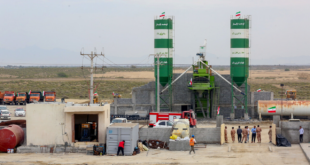On March 15, the China’s National Bureau of Statistics released some of the country’s economic data for January and February. In terms of investment, consumption, and industrial production, the figures for the first two months this year all showed double-digit year-on-year growth. It should be emphasized that the first two months of substantial growth, with a strong low base effect, is somewhat “distorted”. Therefore, analysis of this year’s economic data needs to be compared with the pre-pandemic year in 2019.
First of all, in terms of investment, China’s fixed asset investment (excluding rural households) reached RMB 4.5236 trillion in the January-February period this year, up 35.0% year-on-year; it was 3.5% higher than that from January to February in 2019, with an average growth of 1.7% in two years. Among them, private investment in fixed assets was RMB 2.6183 trillion (accounting for 57.9%), up 36.4% year-on-year; state-owned holding investment in fixed assets was RMB 1.9053 trillion (accounting for 42.1%), up 32.9% year-on-year. By type of registration, the investment of domestic enterprises increased by 34.8% year-on-year, that of Hong Kong, Macao, and Taiwan enterprises rose by 50.0% and that of foreign enterprises increased by 22.9%. Compared with last year, the growth rate of private investment in the first two months of this year is picking up rapidly, and the proportion of private investment is also increasing. In 2020, the growth rate of private investment was only 1% year-on-year, and that of state-owned holding investment was 5.3%. In terms of the proportion of investment, private investment and state-owned holding investment accounted for 55.7% and 44.3% respectively last year.
It is worth mentioning the data of real estate investment. From January to February this year, the investment in real estate development nationwide reached RMB 1.3986 trillion, up 38.3% from 2020 and 15.7% over the January-February period of 2019, with two-year average growth of 7.6%. Of this, residential investment was RMB 1.0387 trillion, up 41.9%. It can be seen that after the impact of last year’s pandemic, real estate investment has rebounded significantly, and its growth rate is not only higher than that of last year, but also higher than that of the same period in 2019.
Second, in terms of consumption, China’s total retail sales of consumer goods reached RMB 6.9737 trillion in the first two months of this year, up 33.8% year-on-year; it was 6.4% higher than that from January to February in 2019, with an average growth of 3.2% in two years. After deducting price factors, the total retail sales of consumer goods grew by 34.3% year-on-year in real terms in the first two months of 2021, with an average growth of 1.2% in two years. It should be pointed out that under the impact of the pandemic, the pace of consumption recovery has been slower than the pace of economic recovery.
The total retail sales of consumer goods in 2020 fell by 3.9% compared with that in 2019, becoming a prominent weakness of the economy in the year. Consumption growth in the first two months exceeded that of the same period in 2019, indicating that the recovery of consumption has picked up further this year. If consumption picks up steadily, it will provide strong support for the economy in 2021.
Administration of Customs show that the total value of Chinese merchandise imports and exports amounted to RMB 5.44 trillion in the first two months of this year, up 32.2% from the same period last year. Among them, exports were RMB 3.06 trillion, an increase of 50.1%; imports were RMB 2.38 trillion, an increase of 14.5%; the trade surplus was RMB 675.86 billion, compared with a deficit of RMB 43.3 billion in the same period last year. In terms of U.S. dollars, the country’s total value of merchandise imports and exports was USD 834.49 billion in the first two months, an increase of 41.2%. Of this, exports were USD 468.87 billion, up 60.6%; imports were USD 365.62 billion, up 22.2%; the trade surplus was USD 103.25 billion, compared with a deficit of USD 7.21 billion in the same period last year. The substantial growth of China’s foreign trade is related to the recovery of China’s economy and manufacturing capacity, as well as the recovery of demand in the external market. With the further improvement of the pandemic situation, the growth of foreign trade this year is promising.
Fourth, in terms of industry, the value-added of industrial enterprises above designated size grew by 35.1% year-on-year in real terms (excluding price factors); it was 16.9% higher than that from January to February in 2019, with an average growth of 8.1% in two years. In terms of month-on-month growth, the value-added of industrial enterprises above designated size increased by 0.69% in February compared with the previous month.
Overall, the economic data in the first two months this year showed a substantial year-on-year growth, which is the result of the combined effects of economic factors, policy factors, and low base effect. After taking the lead in controlling the pandemic in the second half of last year, China accelerated its economic recovery, and this trend has continued into this year. At the same time, external demand has improved as the global pandemic situation has eased. Since the beginning of this year, the world economy has recovered slowly and the manufacturing industry and consumer demand in major economies have picked up, driving the rapid growth of China’s exports. The policy of “stay put during Spring Festival” has played a certain role in boosting industrial production and consumption. According to a survey of nearly 5,000 industrial enterprises by the National Bureau of Statistics, industrial enterprises had 7.5 days off on average during the Spring Festival, significantly less than in usual years; nearly half of the enterprises surveyed said that more than 90% of their employees choose to stay put during the Spring Festival.
The pickup in economic activity earlier this year was also reflected the buoyant factors of production. According to the National Bureau of Statistics, freight volume rose 48.1% year-on-year in the January-February period, with two-year average growth of 7.5%. Electricity consumption increased by 22.2% year-on-year, the two-year average growth being 6.1%. In February, the manufacturing PMI stood at 50.6, and the non-manufacturing business activity index stood at 51.4, both of which were above the critical point for 12 consecutive months, indicating that the economic expectations of enterprises were improving.
Judging from the economic data of the first two months, China’s economy is in the process of recovery, and the first two months this year got off to a very encouraging start. Given this momentum, China’s economic data is expected to see a relatively significant rebound in the first quarter. Quarterly economic growth in the first half of this year is expected to be higher than that in the second half, due to the low base effect. Overall, there will be a low base effect in 2021. In terms of economic policy, both the central and local governments should focus on the sustainability of the economy next year and the year after, and this is what ANBOUND advocates as “three-year vision”. It is worth noting that if the recovery remains solid this year, it could fuel a gradual tightening of monetary policy this year. When economic growth and employment are not in trouble, the macroeconomic policy will focus more on risk prevention, leaving policy room for slower growth in the coming years.
Final analysis conclusion:
Under the economic rebound and low base effect, China’s economic data in the first two months this year got off to a very encouraging start. However, with a view to maintaining economic stability in the coming years, monetary policy is likely to be relatively prudent this year, guarding against risks while preserving policy space for the next few years.
 Eurasia Press & News
Eurasia Press & News



